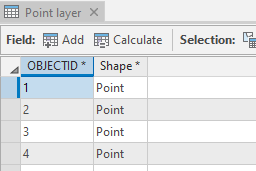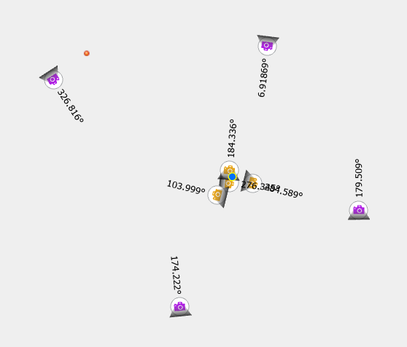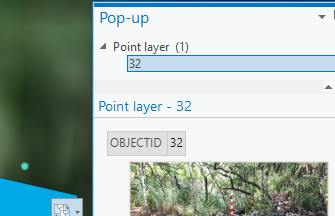- Home
- :
- All Communities
- :
- Products
- :
- ArcGIS Survey123
- :
- ArcGIS Survey123 Questions
- :
- Re: Photo points with meaningful labels
- Subscribe to RSS Feed
- Mark Topic as New
- Mark Topic as Read
- Float this Topic for Current User
- Bookmark
- Subscribe
- Mute
- Printer Friendly Page
- Mark as New
- Bookmark
- Subscribe
- Mute
- Subscribe to RSS Feed
- Permalink
- Report Inappropriate Content
Hey all,
I exported photos to points following the instructions here and here, using photos that we had taken on Collector/S123, then exported. The end result is a feature class that has a list of ObjectID numbers in it, and nothing else.

The original files were correctly labelled based on the geometry they were related to. How can I create a feature class of photo points that is labelled meaningfully or easily related to the source geometry, without having to go back and comb through my photolog?
I am also wondering if someone could confirm something for me. I think I saw in the user conference this summer that photo points showing direction were coming to soon/are in Workforce already, but are not coming to S123 for a while. Is this correct?
Thanks!
Solved! Go to Solution.
Accepted Solutions
- Mark as New
- Bookmark
- Subscribe
- Mute
- Subscribe to RSS Feed
- Permalink
- Report Inappropriate Content
Okay, so I went ahead with my idea (more on that in a second), but in the process I checked the visualization on AGOL, rather than Pro, and it shows the file name in the attachments list (It doesn't show the photo itself, which it does by default in Pro. Weird.) . So at least on AGOL it's not that hard to see what is what.
I think that if you're just working on AGOL, it might be possible to use Arcade to grab the attachments' names to populate the title of the pop-up?
What I ended up doing (posting in detail for posterity):
- create a file tree in a csv (can't make readable .xls files using the tree command)
- edit the data as needed, removing any extraneous lines and spaces, as well as creating a RELID field
- copy-paste or save-as to .xls file
- Excel to File
- Join Field tool
- Configure pop-up as desired
The end result is that the points actually make sense
 | 
|
| AGOL | ArcGIS Pro |
Of course, that being said, I realized that there's a much more efficient way to do this, namely GeoTagged Photos To Points (Data Management)—ArcGIS Pro | Documentation
The end result is exactly what I was looking for, and if you play with the symbology a bit, you can get photopoints with direction, too.
 |  |
While I was setting it up though, I realized that my data wasn't that great, so I looked into why that was. (Spoilered because this is getting off topic)
I took a photo in each of the cardinal directions at the same spot in Collector, with
A) my GNSS device held in my hand as I turned,
B) the GNSS device on a fixed point while I turned
C) the GNSS device on a fixed point, while I stood offset from it by roughly 4 feet.
D) my cell phone, which is the same device used for collection, through the camera app
I then realized that my location was off in the Camera app, and I wondered what difference that would make (very little in Collector, as it turns out), so I repeated that for a total of 28 photos: 24 in Collector, 4 in the Camera app.
As it turns out, the photos taken in Collector have bad accuracy, being on average 92° off in either direction, ranging from 12° to 184° off. This largely consistent across the board, with series A and B both averaging 104 off. The photos taken in the Camera app varied by 9.5° on average, ranging from 4° to 18° off.
Testing in S123, using both an integrated and external GPS held in hand , I got an average variance of 6.8° off in either direction, ranging from 0° to 15 over 24 photos. Looking more closely at my data, I was consistently 10° off from East while doing this, which I think is user error, so the variance is probably smaller.
I honestly assumed that the two platforms would be similar in accuracy, but it wasn't even close.
A quick test showed that the photos taken in S123 are located correctly relative to the survey point.
 |
| Orange is the point taken in Collector. The Blue point is the S123 point, taken in the same location. Photos were taken roughly 5 steps from the survey point in each cardinal direction. South was poorly paced, and the angles eye-balled. |
As an afterthought, I took a series of 8 photos in Field Maps, on the point and 5 paces in either direction, to see what would happen. Field Maps was more accurate in location than Collector, but still suffered by as much as 90° variance.
 |
| 8 more photos were taken attached to the Orange point. They ended up clustered around the Blue point |
The original point in Collector was taken the day before the data was collected in S123 and Field Maps, which probably accounts for the offset, although there is a whole 4 meters between the two of them.
I'm wondering how it comes together when either passing parameters from Collector/Field Maps to S123 or when using S123 to edit an existing FC, but that's a puzzle for another day.
I'm interested in seeing how the tech improve, particularly as photo points are added as their own thing to the various platforms.
TLDR: S123 gives much better location/direction information to photos than Collector does, and better direction than Field Maps.
- Mark as New
- Bookmark
- Subscribe
- Mute
- Subscribe to RSS Feed
- Permalink
- Report Inappropriate Content
- Mark as New
- Bookmark
- Subscribe
- Mute
- Subscribe to RSS Feed
- Permalink
- Report Inappropriate Content
Hey Doug, thanks for the response.
While that is good information to have, it isn't the answer to my question; those links pertain to adding fields to the attachment table or the initial exporting of the photos from the attachment table.
In this situation, I have 1) Exported the photographs from Collector/S123, during which they have been named (E.g. Site_1001_FeatureA_Photo1.jpg), then 2) compressed those photos into a zipfile and uploaded it to AGOL to create a stand-alone point layer where each photo is geo-tagged.*
 | 
|
| Blue Square representing a site, orange dots are photo points | Pop-up of the the Photo Point Layer |
The problem that I'm trying to work around is that this new photo point layer has exactly no identifying information in it; although the photos themselves pop up fine, none of the file names were maintained. What remains is an ObjectID field, which is in alphabetical order of the original file names, and a geometry field. If you double-click the photo, it's the same information plus an unintelligible string
The work-around idea I have for this is grabbing a list of the photos in the zip file, creating a table of their names and what their ObjectIDs should be, then joining the table to the photo points layer. It should work just fine, but I feel like there should be a more efficient way to do this.
This is something I would want a solution for even if I were uploading a collection of photos all named IMG_####; there's no point in creating a photo point layer if you have to open up and look at each photo, rather than its name, to figure out what it is.
*If anyone has tips for getting better, more precise location information on photos taken in Collector/S123, I'd appreciate it. I think they're using the cell phone's internal GPS, rather than the receiver used to collect the geometry.
- Mark as New
- Bookmark
- Subscribe
- Mute
- Subscribe to RSS Feed
- Permalink
- Report Inappropriate Content
Yep all of this is why most of us export and use a web browser. I never store any attachments in feature classes as they are just such a pain to deal with. Photos are not handled well across the platform IMO. We create known format URLs to the photo then add that as a html link in the point feature. Well actually now a link to a HTML gallery of all the photos for that point. Works well and since I cannot get my users to give up excel, they really like that the photo links still work on export.
To do what you want I am thinking you would need to modify the export script to create a field with the filename. Then you could use that for labels and such in this new web map you are making.
Maybe someone else has some other ideas.
- Mark as New
- Bookmark
- Subscribe
- Mute
- Subscribe to RSS Feed
- Permalink
- Report Inappropriate Content
Okay, so I went ahead with my idea (more on that in a second), but in the process I checked the visualization on AGOL, rather than Pro, and it shows the file name in the attachments list (It doesn't show the photo itself, which it does by default in Pro. Weird.) . So at least on AGOL it's not that hard to see what is what.
I think that if you're just working on AGOL, it might be possible to use Arcade to grab the attachments' names to populate the title of the pop-up?
What I ended up doing (posting in detail for posterity):
- create a file tree in a csv (can't make readable .xls files using the tree command)
- edit the data as needed, removing any extraneous lines and spaces, as well as creating a RELID field
- copy-paste or save-as to .xls file
- Excel to File
- Join Field tool
- Configure pop-up as desired
The end result is that the points actually make sense
 | 
|
| AGOL | ArcGIS Pro |
Of course, that being said, I realized that there's a much more efficient way to do this, namely GeoTagged Photos To Points (Data Management)—ArcGIS Pro | Documentation
The end result is exactly what I was looking for, and if you play with the symbology a bit, you can get photopoints with direction, too.
 |  |
While I was setting it up though, I realized that my data wasn't that great, so I looked into why that was. (Spoilered because this is getting off topic)
I took a photo in each of the cardinal directions at the same spot in Collector, with
A) my GNSS device held in my hand as I turned,
B) the GNSS device on a fixed point while I turned
C) the GNSS device on a fixed point, while I stood offset from it by roughly 4 feet.
D) my cell phone, which is the same device used for collection, through the camera app
I then realized that my location was off in the Camera app, and I wondered what difference that would make (very little in Collector, as it turns out), so I repeated that for a total of 28 photos: 24 in Collector, 4 in the Camera app.
As it turns out, the photos taken in Collector have bad accuracy, being on average 92° off in either direction, ranging from 12° to 184° off. This largely consistent across the board, with series A and B both averaging 104 off. The photos taken in the Camera app varied by 9.5° on average, ranging from 4° to 18° off.
Testing in S123, using both an integrated and external GPS held in hand , I got an average variance of 6.8° off in either direction, ranging from 0° to 15 over 24 photos. Looking more closely at my data, I was consistently 10° off from East while doing this, which I think is user error, so the variance is probably smaller.
I honestly assumed that the two platforms would be similar in accuracy, but it wasn't even close.
A quick test showed that the photos taken in S123 are located correctly relative to the survey point.
 |
| Orange is the point taken in Collector. The Blue point is the S123 point, taken in the same location. Photos were taken roughly 5 steps from the survey point in each cardinal direction. South was poorly paced, and the angles eye-balled. |
As an afterthought, I took a series of 8 photos in Field Maps, on the point and 5 paces in either direction, to see what would happen. Field Maps was more accurate in location than Collector, but still suffered by as much as 90° variance.
 |
| 8 more photos were taken attached to the Orange point. They ended up clustered around the Blue point |
The original point in Collector was taken the day before the data was collected in S123 and Field Maps, which probably accounts for the offset, although there is a whole 4 meters between the two of them.
I'm wondering how it comes together when either passing parameters from Collector/Field Maps to S123 or when using S123 to edit an existing FC, but that's a puzzle for another day.
I'm interested in seeing how the tech improve, particularly as photo points are added as their own thing to the various platforms.
TLDR: S123 gives much better location/direction information to photos than Collector does, and better direction than Field Maps.


